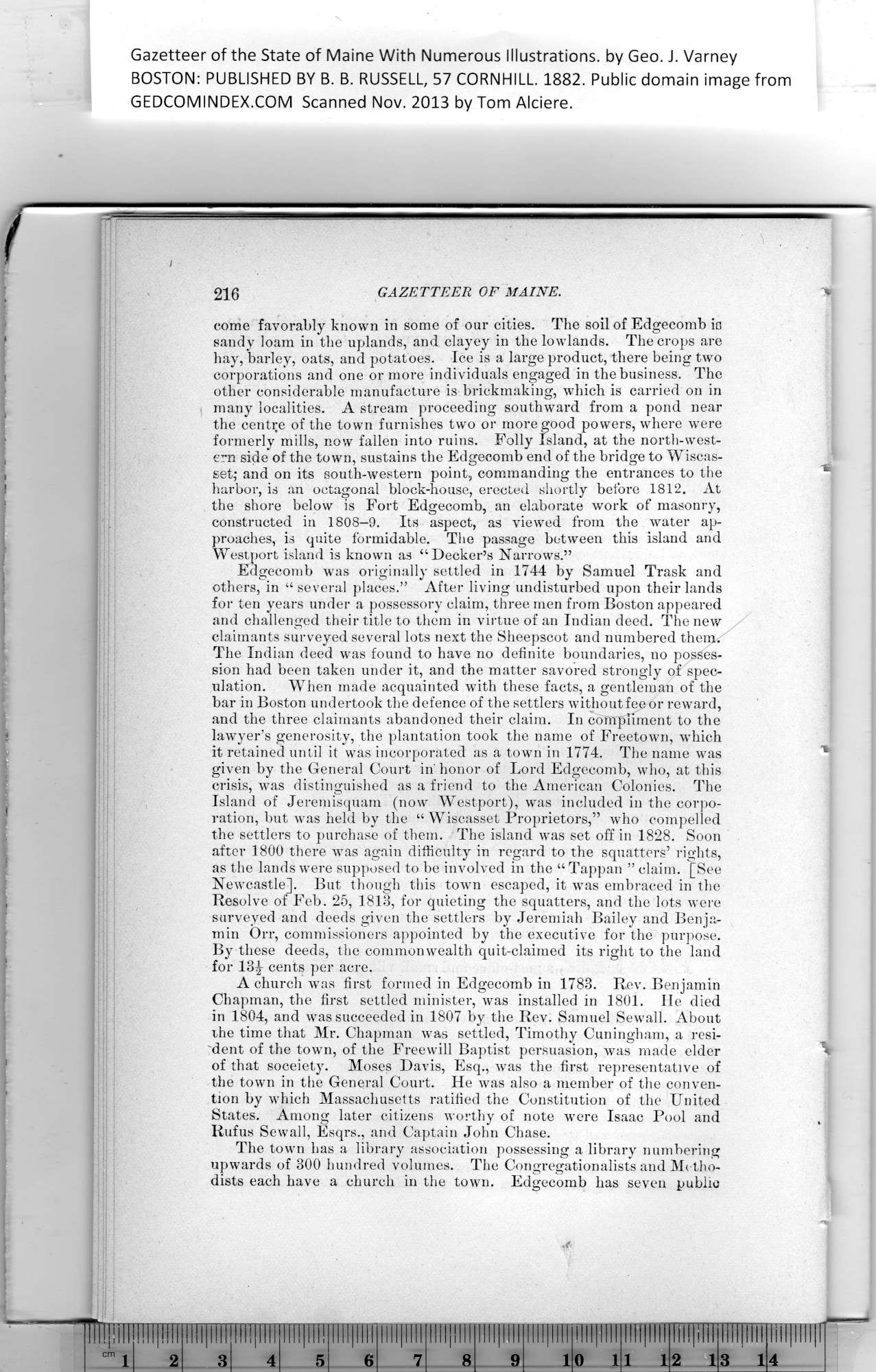|
Gazetteer of the State of Maine With Numerous Illustrations, by Geo. J. Varney
BOSTON: PUBLISHED BY B. B. RUSSELL, 57 CORNHILL. 1882. Public domain image from
216 GAZETTEER OF MAINE.
come favorably known in some of our cities. The soil of Edgecomb io
sandy loam in the uplands, and clayey in the lowlands. The crops are
hay, barley, oats, and potatoes. Ice is a large product, there being two
corporations and one or more individuals engaged in the business. The
other considerable manufacture is brickmakiug, which is carried on in
many localities. A stream proceeding southward from a pond near
the centre of the town furnishes two or more good powers, where were
formerly mills, now fallen into ruins. Folly Island, at the north-west-
ern side of the town, sustains the Edgecomb end of the bridge to Wiscas-
set; and on its south-western point, commanding the entrances to the
harbor, is an octagonal block-house, erected shortly before 1812. At
the shore below is Fort Edgecomb, an elaborate work of masonry,
constructed in 1808—9. Its aspect, as viewed from the water ap-
proaches, is quite formidable. The passage between this island and
Westport island is known as “Decker’s Narrows.”
Edgecomb was originally settled in 1744 by Samuel Trask and
others, in “several places.” After living undisturbed upon their lands
for ten years under a possessory claim, three men from Boston appeared
and challenged their title to them in virtue of an Indian deed. The new /
claimants surveyed several lots next the Sheepscot and numbered themv
The Indian deed was found to have no definite boundaries, no posses-
sion had been taken under it, and the matter savored strongly ofbpec-
ulation. When made acquainted with these facts, a gentleman of the
bar in Boston undertook the defence of the settlers without fee Or reward,
and the three claimants abandoned their claim. In compliment to the
lawyer’s generosity, the plantation took the name of Freetown, which
it retained until it was incorporated as a town in 1774. The name was
given by the General Court in' honor of Lord Edgecomb, who, at this
crisis, was distinguished as a friend to the American Colonies. The
Island of Jeremisquam (now Westport), was included in the corpo-
ration, but was held by the “ Wiscasset Proprietors,” who compelled
the settlers to purchase of them. The island was set off in 1828. Soon
after 1800 there was again difficulty in regard to the squatters’ rights,
as the lands were supposed to be involved in the “ Tappan ” claim. [See
Newcastle]. But though this town escaped, it was embraced in the
Resolve of Feb. 25, 1813, for quieting the squatters, and the lots were
surveyed and deeds given the settlers hy Jeremiah Bailey and Benja-
min Orr, commissioners appointed by the executive for the purpose.
By these deeds, the commonwealth quit-claimed its right to the land
for 13^ cents per acre.
A church was first formed in Edgecomb in 1783. Rev. Benjamin
Chapman, the first settled minister, was installed in 1801. He died
in 1804, and was succeeded in 1807 by the Rev. Samuel Sewall. About
the time that Mr. Chapman was settled, Timothy Cuningham, a resi-
dent of the town, of the Freewill Baptist persuasion, was made elder
of that soceiety. Moses Davis, Esq., was the first representative of
the town in the General Court. He was also a member of the conven-
tion by which Massachusetts ratified the Constitution of the United
States. Among later citizens worthy of note were Isaac Pool and
Rufus Sewall, Esqrs., and Captain John Chase.
The town has a library association possessing a library numbering
upwards of 300 hundred volumes. The Congregationalists and Metho-
dists each have a church in the town. Edgecomb has seven public
PREVIOUS PAGE ... NEXT PAGE
This page was written in HTML using a program written in Python 3.2
|
